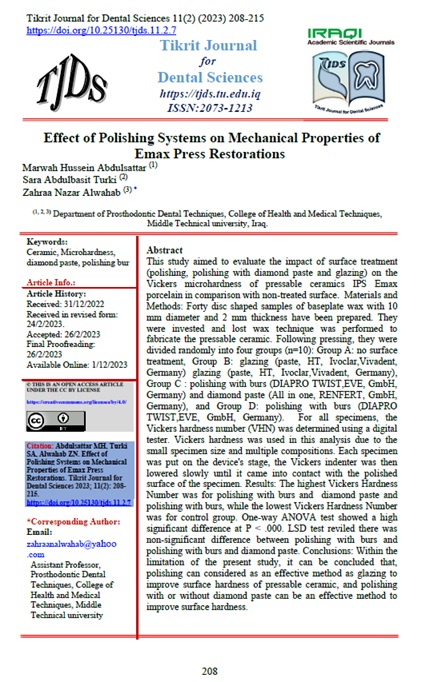Effect of Polishing Systems on Mechanical Properties of Emax Press Restorations
Marwah Hussein Abdulsattar
Department of Prosthodontic Dental Techniques, College of Health and Medical Techniques, Middle Technical university, Iraq
Sara Abdulbasit Turki
Department of Prosthodontic Dental Techniques, College of Health and Medical Techniques, Middle Technical university, Iraq
Zahraa Nazar Alwahab
Department of Prosthodontic Dental Techniques, College of Health and Medical Techniques, Middle Technical university, Iraq.
DOI: https://doi.org/10.25130/tjds.11.2.7
Keywords: Ceramic, Microhardness, diamond paste, polishing bur
Abstract
This study aimed to evaluate the impact of surface treatment (polishing, polishing with diamond paste and glazing) on the Vickers microhardness of pressable ceramics IPS Emax porcelain in comparison with non-treated surface. Materials and Methods: Forty disc shaped samples of baseplate wax with 10 mm diameter and 2 mm thickness have been prepared. They were invested and lost wax technique was performed to fabricate the pressable ceramic. Following pressing, they were divided randomly into four groups (n=10): Group A: no surface treatment, Group B: glazing (paste, HT, Ivoclar,Vivadent, Germany) glazing (paste, HT, Ivoclar,Vivadent, Germany), Group C : polishing with burs (DIAPRO TWIST,EVE, GmbH, Germany) and diamond paste (All in one, RENFERT, GmbH, Germany), and Group D: polishing with burs (DIAPRO TWIST,EVE, GmbH, Germany). For all specimens, the Vickers hardness number (VHN) was determined using a digital tester. Vickers hardness was used in this analysis due to the small specimen size and multiple compositions. Each specimen was put on the device's stage, the Vickers indenter was then lowered slowly until it came into contact with the polished surface of the specimen. Results: The highest Vickers Hardness Number was for polishing with burs and diamond paste and polishing with burs, while the lowest Vickers Hardness Number was for control group. One-way ANOVA test showed a high significant difference at P < .000. LSD test reviled there was non-significant difference between polishing with burs and polishing with burs and diamond paste. Conclusions: Within the limitation of the present study, it can be concluded that, polishing can considered as an effective method as glazing to improve surface hardness of pressable ceramic, and polishing with or without diamond paste can be an effective method to improve surface hardness.




